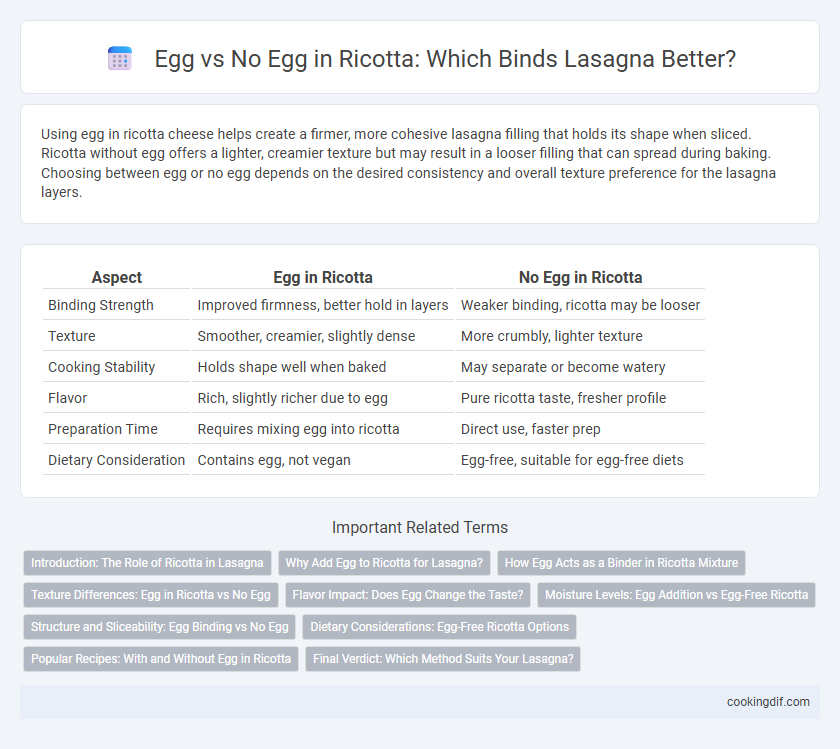Using egg in ricotta cheese helps create a firmer, more cohesive lasagna filling that holds its shape when sliced. Ricotta without egg offers a lighter, creamier texture but may result in a looser filling that can spread during baking. Choosing between egg or no egg depends on the desired consistency and overall texture preference for the lasagna layers.
Table of Comparison
| Aspect | Egg in Ricotta | No Egg in Ricotta |
|---|---|---|
| Binding Strength | Improved firmness, better hold in layers | Weaker binding, ricotta may be looser |
| Texture | Smoother, creamier, slightly dense | More crumbly, lighter texture |
| Cooking Stability | Holds shape well when baked | May separate or become watery |
| Flavor | Rich, slightly richer due to egg | Pure ricotta taste, fresher profile |
| Preparation Time | Requires mixing egg into ricotta | Direct use, faster prep |
| Dietary Consideration | Contains egg, not vegan | Egg-free, suitable for egg-free diets |
Introduction: The Role of Ricotta in Lasagna
Ricotta cheese serves as a creamy binder in lasagna, contributing to the dish's rich texture and balanced moisture. Incorporating egg into ricotta enhances its firmness and stability, preventing the filling from becoming too runny during baking. Conversely, ricotta without egg produces a softer, more delicate consistency but may require additional care to maintain structure in the layered pasta.
Why Add Egg to Ricotta for Lasagna?
Adding egg to ricotta in lasagna enhances the cheese mixture's ability to bind, creating a firmer, more cohesive layer that prevents separation during baking. The egg's proteins coagulate under heat, improving texture and ensuring the filling holds its shape when sliced. Without egg, ricotta tends to be looser and can cause the lasagna layers to slide apart, resulting in a less structured dish.
How Egg Acts as a Binder in Ricotta Mixture
Egg in ricotta acts as a natural binder by coagulating proteins during baking, which enhances the structure and firmness of the lasagna filling. Without egg, the ricotta mixture can be creamier but may lack the stability needed to hold its shape when sliced. The protein in egg provides cohesion, reducing runniness and ensuring a more consistent texture in traditional lasagna recipes.
Texture Differences: Egg in Ricotta vs No Egg
Egg in ricotta creates a firmer, more cohesive texture that holds the lasagna layers together, providing a custard-like consistency when baked. Without egg, ricotta remains creamier and softer, resulting in a more delicate, slightly loose texture within the lasagna. The presence of egg enhances structural integrity, while omitting it emphasizes a lighter, more tender bite.
Flavor Impact: Does Egg Change the Taste?
Incorporating egg into ricotta for lasagna enhances creaminess and adds a subtle richness without overpowering the dish's delicate flavors. Omitting egg results in a lighter texture that allows the fresh tang of ricotta and herbs to shine more prominently. The presence or absence of egg subtly shifts the flavor profile, balancing between a richer, more custardy filling and a fresher, more vibrant taste.
Moisture Levels: Egg Addition vs Egg-Free Ricotta
Adding egg to ricotta in lasagna enhances binding by reducing excess moisture, resulting in a firmer, more cohesive texture. Egg-free ricotta retains higher moisture levels, which can lead to a softer, creamier consistency but may cause the lasagna to be slightly more watery. Optimal moisture control depends on the desired texture, with egg inclusion tightening the structure while egg-free ricotta preserves a delicate, rich mouthfeel.
Structure and Sliceability: Egg Binding vs No Egg
Using egg in ricotta enhances lasagna's structure by providing stronger binding, resulting in firmer layers that hold their shape when sliced. Without egg, ricotta remains softer and more delicate, causing the lasagna to be creamier but less stable, which can lead to a more fragile slice. The presence of egg improves sliceability by creating cohesive, well-defined layers that maintain integrity during serving.
Dietary Considerations: Egg-Free Ricotta Options
Egg-free ricotta options provide a suitable alternative for individuals with egg allergies or those following vegan or vegetarian diets, ensuring safe consumption. These alternatives often use plant-based binders or thickeners like tofu, cashews, or cornstarch to maintain the creamy texture and improve binding without compromising flavor. Choosing egg-free ricotta enhances dietary inclusivity and accommodates diverse nutritional needs while preserving the classic lasagna experience.
Popular Recipes: With and Without Egg in Ricotta
Popular lasagna recipes vary in ricotta preparation, with some incorporating egg to enhance binding and achieve a firmer texture in the layers. Traditional Italian lasagna often omits egg, relying on the ricotta's natural creaminess and moisture to blend with the sauce and cheese for a softer, more delicate consistency. Recipes with egg in ricotta appeal to cooks seeking a stable, sliceable lasagna, while those without egg favor a lighter, creamier mouthfeel favored in many regional Italian styles.
Final Verdict: Which Method Suits Your Lasagna?
Using egg in ricotta enhances the cheese mixture's firmness and stability, preventing it from becoming watery during baking, which is ideal for lasagna recipes requiring distinct, structured layers. Omitting egg results in a creamier, softer texture that melds more smoothly with other ingredients, preferred in lighter, more delicate lasagna versions. Choose egg in ricotta for firmer slices and defined layering, or skip the egg for a silkier, more cohesive filling that suits softer, less rigid lasagna preparations.
Egg in ricotta vs No egg in ricotta for binding Infographic

 cookingdif.com
cookingdif.com